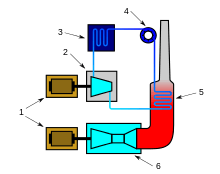Nameplate capacity
Nameplate capacity, also known as the rated capacity, nominal capacity, installed capacity, or maximum effect, is the intended full-load sustained output of a facility such as a power plant,[1][2] a chemical plant,[3] fuel plant,[4][5][6] metal refinery,[7] mine,[8] and many others. Nameplate capacity is the number registered with authorities for classifying the power output of a power station usually expressed in megawatts (MW).[9]
Power plants with an output consistently near their nameplate capacity have a high capacity factor.
Dispatchable power
For dispatchable power, this capacity depends on the internal technical capability of the plant to maintain output for a reasonable amount of time (for example, a day), neither momentarily nor permanently, and without considering external events such as lack of fuel or internal events such as maintenance.[10] Actual output can be different from nameplate capacity for a number of reasons depending on equipment and circumstances.[10][11]
Non-dispatchable power
For non-dispatchable power, particularly renewable energy, nameplate capacity refers to generation under ideal conditions. Output is generally limited by weather conditions, hydroelectric dam water levels, tidal variations and other outside forces. Equipment failures and maintenance usually contribute less to capacity factor reduction than the innate variation of the power source. In photovoltaics, capacity is rated under Standard Test Conditions usually expressed in the non-SI compliant unit watt-peak (Wp). In addition, a PV system's nameplate capacity is sometimes denoted by a subindex, for example, MWDC or MWAC, in order to clarify, whether the raw DC or already converted AC power output is referred to.
Generator capacity

The term is connected with nameplates on electrical generators as these plates describing the model name and manufacturer usually also contain the rated output,[12] but the rated output of a power station to the electrical grid is usually less than the generator capacity because the components outside the generator, but inside the power station, also use power, which detracts from the amount that reaches the grid. Thus there is a distinction between component capacity and facility capacity.
See also
- Availability factor
- Declared net capacity (power plants)
- Electricity generation
- Intermittent power source#Terminology
- List of energy storage projects
References
- ↑ Energy glossary Energy Information Administration. Retrieved: 23 September 2010.
- ↑ Glossary Nuclear Regulatory Commission, 2 August 2010. Retrieved: 23 September 2010.
- ↑ Plant Performance Data (PPD) ICIS. Retrieved: 23 September 2010.
- ↑ Refinery Economics Natural Resources Canada, 5 january 2009. Retrieved: 23 September 2010.
- ↑ Magnificent seven Arabian Business, 17 June 2008. Retrieved: 23 September 2010.
- ↑ Daniel O’Brien and Mike Woolverton. Trends in U.S. fuel ethanol production capacity: 2005-2009 K-State & Extension, August 2009. Retrieved: 23 September 2010.
- ↑ Refining Capacity Alcoa, December 31, 2009 . Retrieved: 23 September 2010.
- ↑ The Future of Tantalum and Niobium Mining-Technology, 14 Jan 2010. Retrieved: 23 September 2010.
- ↑ Certificate of Nameplate Capacity Ohio Department of Development. Retrieved: 23 September 2010.
- 1 2 Kleiser, Thomas. Response to CDM page 2-4 by TÜV, 4 March 2009. Retrieved: 23 September 2010.
- ↑ Swain, Bibb. Designed to go above Nameplate Capacity Ethanol Producer, November 2006. Retrieved: 23 September 2010.
- ↑ Reitze, Arnold W. Air pollution control law: compliance and enforcement page 260 George Washington University Law School, 2001. ISBN 1-58576-027-7, ISBN 978-1-58576-027-5 Retrieved: 23 September 2010.
| ||||||||||||||||||||||||||||||||